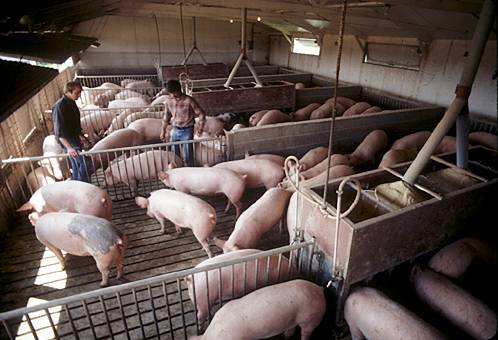
by Sarah Baker, Staff Member
The great majority of Americans enjoy their commercially produced meat—hotdogs, chicken, steaks, bacon, and ham. We spend less on our packaged protein, trust the safety of the greater food supply, and are well served by modern agriculture methods, or so it would seem.
But, at what cost to our health?
This question is one the Obama administration has been asking over the past year in its efforts to ban antibiotics from being used in healthy animals. Patty Khuly, Antibiotics Benefit Farm Animals (and People) But at What Cost?, USA Today, March 11, 2010 available at http://www.usatoday.com/life/lifestyle/pets/2010-03-10-dolittler11_N.htm. Intended to promote growth and prevent disease, the animal agricultural industry feeds hogs, chicken, and cattle a daily dose of antimicrobial drugs. As a result, the animals grow larger, faster and healthier. Id. However, antibiotic resistance is an emerging threat.
When antibiotics are supplied to healthy animals in low doses for a long duration of time, resistance to the drugs build up, enabling bacteria to survive and multiply instead of being destroyed. The Pew Campaign on Human Health and Industrial Farming, Antibiotic Resistance and the Industrial Animal Farm, http://www.saveantibiotics.org/resources/PewAMRfactsheetfinal1.pdf (last visited Oct. 26, 2010). Humans can acquire the resistant bacteria by eating meat from these animals or by not using proper sanitation techniques during food handling or preparation. Id. Many of the antibiotics given to animals are very similar to those used to treat humans, including tetracyclines and penicillins, among others. Id. Therefore, the bacteria becoming resistant to the drugs in animals are also likely to be resistant to those drugs when proscribed to sick humans.
The impact of bacteria resistance is finally gaining some attention on the national political scene. Some recent findings show that up to seventy percent of U.S. antibiotics go to healthy farm animals to offset crowding and poor sanitation on industrial farms, and 300,000 hospitalizations and 5,000 human deaths each year are caused by foods containing E. coli and salmonella, which are increasingly becoming antibiotic resistant. Id. Statistics of this magnitude are too frightening to be ignored.
President Obama has proposed a ban on non-therapeutic antimicrobials in animal feed. Opponents, however, argue that the use of antibiotics in the animal agricultural industry keeps animal sickness manageable in crowded environments, and costs low in the supermarket. Khuly, supra. As a meat loving people, however, we must consider the implications of current agriculture practice and long-term health consequences. I’ll take a burger, minus the antibiotic resistant bacteria, please.
But, at what cost to our health?
This question is one the Obama administration has been asking over the past year in its efforts to ban antibiotics from being used in healthy animals. Patty Khuly, Antibiotics Benefit Farm Animals (and People) But at What Cost?, USA Today, March 11, 2010 available at http://www.usatoday.com/life/lifestyle/pets/2010-03-10-dolittler11_N.htm. Intended to promote growth and prevent disease, the animal agricultural industry feeds hogs, chicken, and cattle a daily dose of antimicrobial drugs. As a result, the animals grow larger, faster and healthier. Id. However, antibiotic resistance is an emerging threat.
When antibiotics are supplied to healthy animals in low doses for a long duration of time, resistance to the drugs build up, enabling bacteria to survive and multiply instead of being destroyed. The Pew Campaign on Human Health and Industrial Farming, Antibiotic Resistance and the Industrial Animal Farm, http://www.saveantibiotics.org/resources/PewAMRfactsheetfinal1.pdf (last visited Oct. 26, 2010). Humans can acquire the resistant bacteria by eating meat from these animals or by not using proper sanitation techniques during food handling or preparation. Id. Many of the antibiotics given to animals are very similar to those used to treat humans, including tetracyclines and penicillins, among others. Id. Therefore, the bacteria becoming resistant to the drugs in animals are also likely to be resistant to those drugs when proscribed to sick humans.
The impact of bacteria resistance is finally gaining some attention on the national political scene. Some recent findings show that up to seventy percent of U.S. antibiotics go to healthy farm animals to offset crowding and poor sanitation on industrial farms, and 300,000 hospitalizations and 5,000 human deaths each year are caused by foods containing E. coli and salmonella, which are increasingly becoming antibiotic resistant. Id. Statistics of this magnitude are too frightening to be ignored.
President Obama has proposed a ban on non-therapeutic antimicrobials in animal feed. Opponents, however, argue that the use of antibiotics in the animal agricultural industry keeps animal sickness manageable in crowded environments, and costs low in the supermarket. Khuly, supra. As a meat loving people, however, we must consider the implications of current agriculture practice and long-term health consequences. I’ll take a burger, minus the antibiotic resistant bacteria, please.
No comments:
Post a Comment